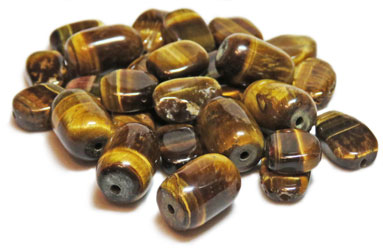

Tiger’s eye is a striped brown and golden variety of chalcedony (microcrystaline quartz). Though a common gemstone, tiger’s eye is made a unique form of quartz by its chatoyancy, an effect caused by minute parallel fibers, cavities or tubes, or needlelike inclusions that cause a wavy sheen that changes position as the gemstone is turned. Similar to petrified wood, tiger’s eye is a pseudomorph, with quartz replacing the bluish-gray fibrous mineral crocidolite, a type of asbestos. Tiger’s eye is formed when the quartz takes over and dissolves the crocidolite, leaving the it in a finely fibrous and chatoyant form.
| Chemical Formula | SiO2 | Mineral Class | Quartz (Chalcedony) |
|---|---|---|---|
| Color | Yellow, Brown, Multicolored | ||
| Crystal System | Hexagonal | Hardness | 7 |
| Transparency | Opaque | Luster | Silky |
| Refractory Index | 1.544 - 1.553 | Double Refraction | None |
Tiger’s eye, a most ancient talisman, was believed to be an “all-seeing, all-knowing eye,” thought to grant a wearer the ability to observe everything.
The Egyptians used tiger’s eye for the eyes in their deity statues to express divine vision. It was believed to provide the protection of the sun and earth combined, of Ra, the sun god and Geb, god of the growing land.
Believed to be linked to the magical tiger, the king of beasts in Eastern mythology, tiger’s eye represented courage, integrity and the right use of power.
Roman soldiers carried tiger’s eye to deflect weapons and to be brave in battle.
Highly regarded throughout history as a stone of prosperity and good fortune, tiger’s eye was believed to protect one’s resources and reflect back malice or threats from others.
Historically tiger’s eye was believed to be the most powerful talisman of abundance and protection against the evil eye.
In the ancient world of the Orient tiger’s eye was considered to always bring good fortune to the wearer.
In Chinese medicine, tiger’s eye was believed to restore yin and yang energies.
Tiger’s eye was believed to discern if someone else was reliable or not and, by the end of the day, any deception would be revealed.
Believed to help one remain calm and courageous, tiger’s eye was used to stay focused and to persevere.
Today tiger’s eye is believed beneficial for children, by enhancing concentration for study, and giving them a sense of security and courage. It also is considered to strengthen willpower and help timid children to be more confident, especially when bullied or if they feel alienated from peers.
Tiger’s eye is also considered to reduce anxiety caused by feelings of isolation or inadequacy and to help one to persevere.
Believed to be a stone of harmony, tiger’s eye is a wonderful talisman for mediators or those going through difficult negotiations.
In modern times tiger’s eye is attributed with spiritual healing properties by imparting compassion, grace, and unconditional love.
Tiger’s eye is also believed to help fight addictive behaviors by minimizing cravings for foods and addictive substances.
The golden to brown quartz works well with the base, sacral and solar plexus chakras. Balance and harmony imparted by this stone, as supported by tiger’s eye crystal meaning, make it well-suited to these chakras.
Tiger's eye helps to energize and activate the solar plexus chakra, the energy center associated with willpower and motivation. Also, because of its vibrations from the sun, tiger's eye properties support the energy of the entire body by filling one’s energy field with warmth and fiery energy.
The use of tiger’s eye at the root or base chakra is believed to be grounding, bringing a centered, calm, state of mind.
Using tiger’s eye at the navel or sacral chakra is believed to manifest one’s deepest desires as well as bolster one's creative energy.